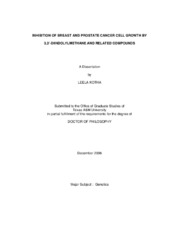| dc.description.abstract | Selective receptor modulators have been developed for steroid hormone
receptors as a new class of mechanism-based drugs for treatment of hormone
related diseases. We investigated an alternative mechanism-based strategy for
treating various cancers with selective aryl hydrocarbon receptor modulators
(SAhRMs), such as diindolylmetane/(DIM), 2,3,7,8-tetrachlorodibenzo-pdioxin/(
TCDD), and 6-6-methyl-1,3,8-trichlorodibenzofuran/(MCDF) that exhibit
antiproliferative activity in several cancer cell lines. MDA-MB-453 and BT-474
are estrogen receptor/(ER) negative breast cancer cell lines that express a
functional aryl hydrocarbon receptor/(AhR) and treatment with SAhRMs
significantly inhibited MDA-MB-453/BT-474 cell proliferation but did not
significantly affect the percent distribution of cells in G0/G1/S/G2/M phases of
cell cycle. TCDD and the SAhRMs had minimal effects on the expression of
various cellular kinases. These data coupled with results obtained for other
activated kinase pathways demonstrate that TCDD and SAhRMs uniquely inhibit
growth of ER-negative MDA-MB 453/BT-474 breast cancer cells through kinase independent pathways. However, the SAhRMs induced HES-1, an
antiproliferative transcription factor, in both cell lines and this might represent a
possible mechanism for the growth inhibitory effects observed with these
compounds.
We proved that ring substituted DIMs exhibit androgenic/antiandrogenic
activities in androgen receptor/(AR)-positive LNCaP/22RV1 prostate cancer cell
lines resulting in antiproliferative activities. These antiproliferative activities were
accompanied by antiandrogenic activity and structure-dependent down
regulation of AR. The ring-substituted DIMs also induced both non-steroidal
anti-inflamatory drug-induced gene-1/(NAG-1) and activating transcription factor
3/(ATF-3), two anti-proliferative/apoptotic genes which are responsible in part for
the inhibitory effects of these compounds on the proliferation of prostate cancer
cells. | en |


